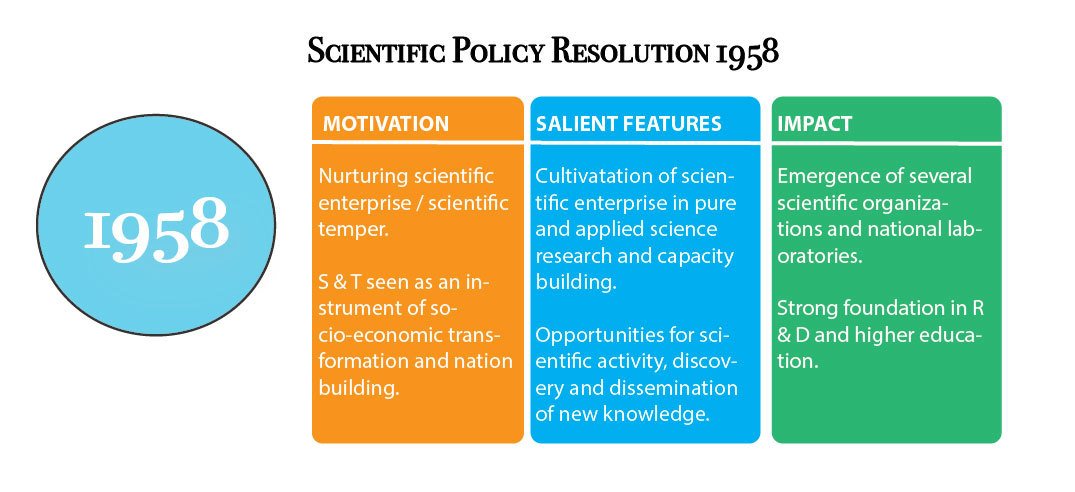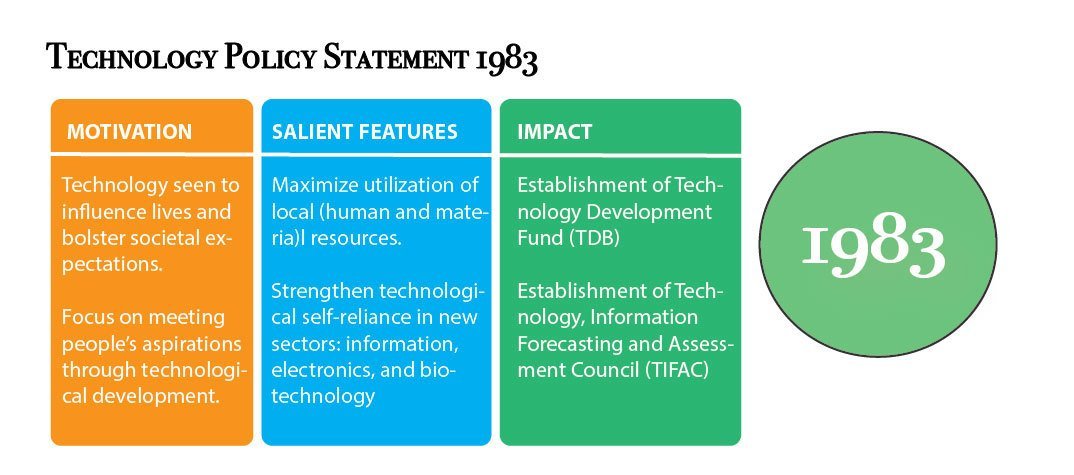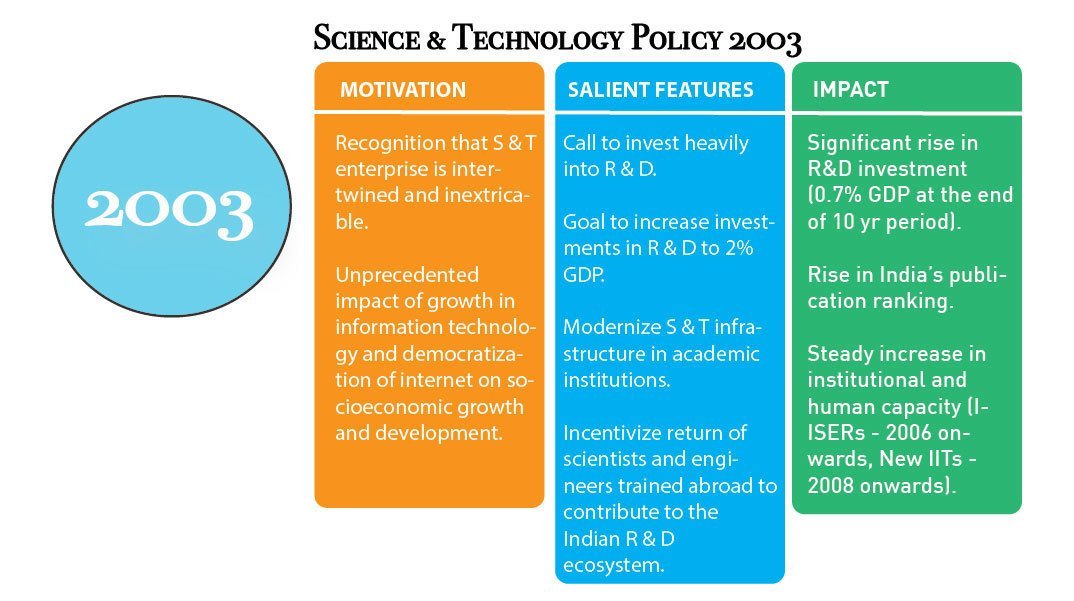Four major policies have been implemented since independence namely, Scientific Policy Resolution (SPR1958), Technology Policy Statement 1983 (SPR1958), Science and Technology Policy 2003 (STP2003), and Science Technology Innovation Policy 2013 (STIP2013), this article will attempt to give a retrospective on how the STI ecosystem that we see today came into being.
Since our independence in 1947, India has been successful in building a massive ecosystem of science, technology and innovation (STI). An STI ecosystem includes universities, public and private enterprises, and human resources. We have over 16,000 colleges, ~600 universities, ~2000 research and development institutes, and over 4,00,000 science professionals, as per data collected during 2010–11 (source: www.data.gov.in). Some of the top scientists, technologists and CEOs of the world have been beneficiaries of our science and policy ecosystem. This has been made possible through the implementation of robust policies by central and state governments over the years.
The first article in this Science Policy 101 series delved into the processes and institutions that go into creating policy for science. By discussing four major policies implemented since independence namely, Scientific Policy Resolution (SPR1958), Technology Policy Statement 1983 (SPR1958), Science and Technology Policy 2003 (STP2003), and Science Technology Innovation Policy 2013 (STIP2013), this article will attempt to give a retrospective on how the STI ecosystem that we see today came into being.
Scientific Policy Resolution (SPR 1958)
Our first major science policy can be traced back to the year 1958. The policy document was drafted by the government of the then Prime Minister of India, Jawaharlal Nehru. SPR1958 laid the foundation of scientific enterprise and scientific temper in India. Nehru had imagined India to be a welfare state. This resolution was born out of the realisation that the creation of a welfare state was only possible through investments in science and technology. Science and Technology would thus act as an instrument of socio-economic transformation.
With an aim to provide a reasonable amount of economic, social, cultural amenities and services to every citizen through industrialisation, investment in science and technology was critical as it would reduce the burden on the use of raw materials and capital. It would also reduce the gap between India and the developed countries. Thus, SPR1958 recognised that science and technology were crucial for nation-building and national prosperity.
The purpose of SPR1958 was to cultivate scientific enterprise in pure science research, applied science research and capacity building at a large scale. In order to achieve this goal, SPR1958 recognised that it was essential to develop educational programmes to ensure an adequate supply of scientists.
Creating a pool of high-quality scientists on a large scale was necessary to fulfil the country’s needs, especially in areas such as agriculture and defence. SPR1958 highlighted that it was important to create a culture and mechanism where creative talents of citizens are recognised and opportunities are found in scientific activity, acquisition, dissemination, and discovery of new knowledge.
SPR1958 was primarily a science policy document. Technology development was given secondary importance as it was assumed then that technological development could only stem through the study of science and its applications. However, post-SPR 1958, large scale investments in science resulted in the emergence of several scientific organisations and national laboratories. SPR1958 was able to lay a strong foundation in R&D and higher education.

Technology Policy Statement (TPS 1983)
In the aftermath of passing SPR1958, India spent the next three decades building its scientific enterprise. By the early 1980s, India had developed a strong industrial and agricultural base and also had a large pool of trained human resources.
As technology was increasingly seen to influence lives and bolster societal expectations, the next major policy document, TPS1983, focused primarily on meeting people’s aspiration through technological development.
The primary feature of TPS1983 was technological self-reliance through promotion and development of indigenous technologies. Adoption of indigenous technology would reduce vulnerabilities in critical areas and would help maximise the utilisation of local (human and material) resources. TPS1983 recognised that there should be efficient adoption of imported technologies but not at the cost of national interest. Obsolete technologies had to be identified and replaced with technologies that improve productivity, efficiency, quality and reliability of products using minimum capital and energy utilisation. The fundamental aim was to use technology to provide maximum benefit to all sections of society and especially to improve the conditions of the backward and weaker strata.
Finally, TPS1983 stressed on strengthening the technology base especially in new sectors at that time — information, electronics, and biotechnology through an increase in R&D investments and collaboration amongst governmental organisations, educational institutions and industries.
In order to fulfil the mandate of TPS1983, an implementation committee was set up to draft detailed guidelines for ministries and industries. To bolster indigenous technology development, the Technology Development Fund (TDB) was established to provide financial assistance to Indian industries. TPS1983 highlighted the need for continuous and systematic prediction of how useful emerging and current technologies are going to be in the future (technology forecasting) and assessment studies especially in ministries with large investments and/or production value. With this in mind, technology information forecasting and assessment council (TIFAC) was established.
However, post-1991, economic liberalisation paved the way for large foreign investment in several sectors. Thus, technological self-reliance and adoption of indigenous technologies were at odds with economic policies in several socio-economic sectors where there was a large dependence on foreign investment.

Science and Technology Policy (STP 2003)
By the turn of the millennium, India had established a sound infrastructure base in science and technology in terms of institutions and human resources. However, it was acknowledged that there were dramatic changes in how science was practised, how technology was developed, how science and technology interact and how they affected society. Science was becoming more multidisciplinary, spanning different sectors and different countries. Thus, it required the development of clusters of institutions and multinational collaboration. High investments in R&D were required even in areas of basic research.
SPR1958 and TPS1983 focussed on science and technology respectively and separately. However, the science and technology enterprises were so intertwined that there was a need to think about them together rather than as separate elements.
With rapid advancement in information and communication technologies and the democratisation of the internet, exchange of knowledge and information was occurring at a previously unseen rate. Science and technology started having an unprecedented impact on economic growth and social development. New issues related to cybersecurity and ethics, such as privacy consideration and inequity came to the fore. In order to keep pace with science and technology, to stay competitive in an increasingly globalised world, and to meet our primary goal of equitable and sustainable development, STP2003 was enacted by the Government of India.
A significant feature of STP2003 was a process to develop mechanisms within ministries and agencies to gather inputs from scientists and technologists vis-a-vis planning and policymaking and a call to invest heavily into the R&D sector with an aim of increasing investment to 2% of GDP. STP2003 recognised the need to modernise existing infrastructure for science and engineering in academic institutions and set up new funding mechanisms for basic research. The policy also called for the development of incentive mechanisms to attract scientists and engineers especially of Indian origin from abroad to contribute to the Indian STI ecosystem.
STP2003 was aimed at encouraging R&D and innovation in areas that impact the economy and society, and developing mechanisms to facilitate interaction among various stakeholders within the ecosystem. Finally, STP2003 called for cross-pollination of industry and scientific research, and the establishment of intellectual rights regimes to protect and incentivise inventors. It also encouraged research in management and mitigation of natural hazards. This policy document laid special emphasis on science diplomacy, especially on international science and technological cooperation between developing countries located in the global south.
Post-2003, there was a significant rise in overall R&D investment (raise in both public as well as private investment). At the end of the 10 year period after the adoption of the mandate of STP2003, even though R&D investment did not reach 2% of national GDP as was called for by the mandate, it was at a globally benchmarked figure of 0.7 % of GDP. India made a significant jump in publication rankings. There was also a steady increase in human capacity. We started churning out many more PhD students, more patents were filed, and more startups incubated.

Science, Technology and Innovation Policy (STIP 2013)
The decade of 2010 to 2020 was declared as a decade of innovation by the then Prime Minister Manmohan Singh. It was acknowledged that in order to stay globally competitive, it was necessary to make a transition into a knowledge-based economy.
There was a need to synergise science, technology and innovation to position India amongst the top five global scientific powers. With this objective, the fourth policy, the STIP2013 was implemented.
As the name suggests, a critical new element in this policy document was the term “innovation”. Promoting a science and technology-led innovation ecosystem in the country and broadly linking science, technology and innovation to socio-economic priorities were some of the key aspects of STIP 2013.
This policy document was a step in the right direction towards building a robust national innovation ecosystem. It paved the way for promoting science and technology-led innovation in the country by attracting private-sector contributions into the R & D ecosystem. It laid emphasis on directing scientific discoveries and outputs of science and technology activities towards developmental priorities in key areas (agriculture, manufacturing, water, health, environment and infrastructure).
This policy also resulted in India’s increased participation in global mega-science initiatives such as the Laser Interferometer Gravitational-Wave Observatory (LIGO), the Large Hadron Collider (LHC — CERN), the International Thermonuclear Experimental Reactor (ITER) and the Square Kilometre Array (SKA), among others. However, since we are still within the decade of innovation, an in-depth evaluation of this policy remains to be done to understand its impact in its entirety.

Related policies
In addition to these primary set of STI policies, there are various relevant policies (or components of other policies) which have strong interlinkages and overlapping mandates with the National STI policy. From time to time, these policies are developed and deployed by several agencies/ministries both at central and state levels.
Following is a non-exhaustive (indicative) list of related policies.
| Innovation & Industrial Development
National IPR Policy (2016) [DPIIT] MSME Policy Statement (Central & States) R&D Tax Incentives (Central & State) Startup India Action Plan (2016) [DPIIT] National INNOVATION and STARTUP Policy 2019 for Students and Faculty [MHRD] |
Technology Visions |
| Ethics and Responsibility | Resource Sharing and Accessibility
DBT-DST Open Access Policy (2014) National Data Sharing and Accessibility Policy (NDSAP) (2012) Scientific Research Infrastructure Management and Networks (SRIMAN) (2018) |
| Regional STI Policies
For example, STI Policy Gujarat 2018 and various Information Technology (IT)/ Bio Technology (BT) / Medium, Small & Micro Enterprises (MSME)/Startup Policies at State Level |
|
Conclusion: Indian STI policy is evolving fast with the changing national and international dynamics. The four national policies discussed here were key milestones in this journey. While these policies have had a positive influence on India’s STI ecosystem overall, there are some targets that were missed. One of these is attaining the magic figure of 2% of GDP investments in R&D. The reasons for this could be manifold — inability to attract private funding, incentives being not attractive enough, or simply discrepancies in data reporting. There are various factors which determine the successful implementation of policies. Stable commitment and support from changing/alternative governments, shared ownership and accountability among various implementing agencies, and timely evaluation of policies and associated programmes are some of the important factors in successfully achieving stated policy objectives.
_ _
Disclaimer: This article was first published when the Science Policy Forum was incubated in the IndiaBioscience website. https://indiabioscience.org/columns/indian-scenario/science-technology-and-innovation-sti-policies-in-india-a-flashback






